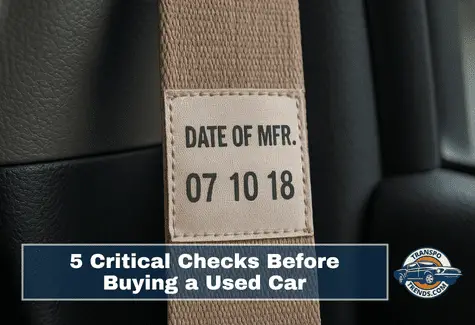Purchasing a used car can be a savvy financial decision, offering significant savings compared to buying new. However, beneath a vehicle’s polished exterior may lie concealed problems that could lead to costly repairs down the line.
To ensure you make an informed purchase, it is essential to conduct thorough inspections. Here are five critical areas to examine before finalizing your used car purchase.
1. Seat Belt Manufacturing Date: Detecting Potential Accident History
Why It Matters: The seat belt’s manufacturing date can reveal if the vehicle has undergone significant repairs, possibly due to an accident.
How to Check:
- Locate the Seat Belt Tag: Pull the seat belt fully out and inspect the tag, usually found near the base.
- Compare Dates: The manufacturing date on the seat belt should align closely with the vehicle’s production date, typically found on a sticker inside the driver’s side door jamb. The US Sun
Red Flags:
- Date Discrepancy: If the seat belt’s manufacturing date is notably newer than the vehicle’s production date, it may indicate that the seat belts were replaced, possibly due to airbag deployment in an accident.
Expert Insight: According to automotive experts, mismatched seat belt dates can suggest previous significant repairs, and caution is advised when considering such vehicles.
2. Rust on Steering Column and Brake Pedals: Signs of Water Damage
Why It Matters: Rust in unusual areas like the steering column and brake pedals can indicate that the vehicle has been exposed to water damage, potentially from flooding.
How to Check:
- Inspect Under the Dashboard: Use a flashlight to examine the steering column and brake pedal assembly for rust or corrosion.
- Check for Musty Odors: A damp, moldy smell inside the cabin can also be a sign of water intrusion.
Red Flags:
- Visible Rust: Rust on components that are not typically exposed to moisture suggests that the car may have been submerged or exposed to excessive water.
Expert Insight: As noted by automotive specialists, rust in these areas is a strong indicator of water damage, and such vehicles may have compromised electrical systems and structural integrity.
3. Sludge Under the Oil Cap: Indicator of Poor Engine Maintenance
Why It Matters: The presence of sludge under the oil cap can signal that the engine has not been properly maintained, leading to potential performance issues and costly repairs.
How to Check:
- Remove the Oil Cap: With the engine off, unscrew the oil cap and inspect the underside for any thick, dark deposits.
- Look Inside the Filler Neck: Use a flashlight to examine the area just inside the oil filler opening for sludge buildup.
Red Flags:
- Thick Deposits: A significant amount of sludge indicates that the oil has not been changed regularly, which can lead to engine wear and reduced efficiency.
Expert Insight: Automotive experts warn that sludge buildup is a sign of neglect and can result in engine failure if not addressed promptly.
4. Frame Symmetry and Structural Integrity: Assessing Accident Damage
Why It Matters: A vehicle’s frame is its structural backbone. Any misalignment or damage can compromise safety and handling.
How to Check:
- Inspect Body Panels: Examine the gaps between doors, hood, and trunk for uniformity. Uneven gaps can indicate frame damage.
- Check for Welding Marks: Look under the car for signs of welding or new paint, which may suggest repairs from a previous accident.
Red Flags:
- Misaligned Panels: Doors or panels that do not close properly or have inconsistent gaps can be a sign of a bent frame.
Expert Insight: According to collision repair professionals, frame damage can lead to poor vehicle handling and increased tire wear, and may require extensive repairs.
5. Unusual Odors and Interior Moisture: Detecting Hidden Water Damage
Why It Matters: Persistent odors and moisture inside the vehicle can indicate water damage, which can lead to mold growth and electrical issues.
How to Check:
- Smell Test: Take a deep breath inside the car. A musty or moldy smell is a red flag.
- Inspect Carpets and Upholstery: Feel the carpets for dampness and look for water stains or discoloration.
Red Flags:
- Condensation in Lights: Foggy headlights or taillights can suggest that water has entered the vehicle’s lighting system.
Expert Insight: Insurance experts note that water-damaged vehicles may have compromised safety systems and are often considered total losses.
Conclusion
When purchasing a used car, it is crucial to look beyond the surface and conduct thorough inspections to uncover any hidden issues.
By checking the seat belt manufacturing date, inspecting for rust in unusual places, examining under the oil cap for sludge, assessing the frame’s symmetry, and being alert to unusual odors and moisture, you can make a more informed decision and avoid potential pitfalls.
Remember, investing time in a detailed inspection now can save you from significant expenses and safety concerns in the future.
If you are uncertain about any findings, consider consulting a professional mechanic for a comprehensive evaluation before finalizing your purchase.

